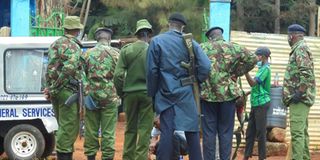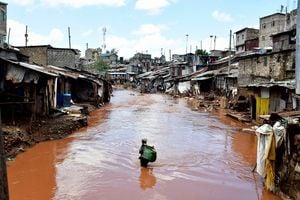Villages in central Kenya still dread return of Mungiki

Police officers seal off the entrance to the Maragua home of a man said to be the Mungiki boss during his burial on August 25, 2020.
What you need to know:
- They may not publicly pronounce themselves as Mungiki.
- But the groups have been employing an identical mode of operation as the killer gang of the 2000s.
- Earlier this month, an insolent gang patrolled Maragua town for days, armed with bows and arrows, machetes, iron bars and axes.
- The Maragua gang is believed be enjoying the protection of rogue administrators and law enforcers.
Horrors of the night of April 20, 2009, will forever remain etched on the minds of residents of Gathaithi in Mathira, Nyeri County.
Under the cover of darkness, Mungiki gang members armed with axes and machetes descended on unsuspecting villagers on a revenge mission.
By the end of the night, 29 people lay dead in one of the sect's bloodiest massacres.
Mutilated bodies lay strewn in pools of blood all over the village, the events of the night leaving behind a cloud of sorrow, and fear that still grips Central region to this day.
More than a decade later, the mere mention of Mungiki, a murderous gang that started out as a harmless sect touting Kikuyu traditional values, is enough to send chills down the spines of many and throw police into reactive crackdowns in a bid to curb its re-emergence. Police maintain that the gang was eliminated.
“For those who knew Mungiki and their style back in the day, they can agree that the gang does not exist,” Central Regional Police Commander Patrick Lumumba told the Nation.
Different story
However, activities in major towns and villages in the region tell a different story.
Findings by the Nation today reveal a consistent and strategic regrouping and re-emergence of gangs affiliated to the dreaded Mungiki.
While they may not publicly pronounce themselves as Mungiki, the groups have been employing an identical mode of operation as the killer gang of the 2000s.
Earlier this month, Maragua town in Murang’a County became a focal point after an insolent gang patrolled the town for days, armed with bows and arrows, machetes, iron bars and axes.
Riding on motorcycles, the gang raided several businesses and attacked passers-by, leaving two nursing serious injuries at Maragua Level Four Hospital. They suffered deep cuts. The attack was seen as a move to terrorise traders not willing to do the gang’s bidding.
The Maragua gang is believed be enjoying the protection of rogue administrators and law enforcers hence their bravado. Ironically, this is the same gang Interior Cabinet Secretary Fred Matiang’i vowed to crush when he toured the region six months ago.
107 arrested
Last week, police conducted a sting operation in the town and arrested 107 people.
But in an interesting turn of events, police now say that they were released without charge because there was no evidence or complaints to support prosecution. Mr Lumumba said the gang was a vigilante group “assisting to enforce Covid-19 health protocols”.
In Nyeri town, not only do matatus have to pay a fee to a gang of seemingly untouchable men at the main terminus downtown, but the gang has reportedly started planning a takeover of a new terminus months before its completion. The money being “taxed” on operators is said to be for allocation of space at the terminus in Asian Quarters.
“For every trip a matatu makes, a fee of between Sh20 and Sh100 has to be paid depending on the route. This feels like Mungiki all over again,” an operator who requested anonymity on safety grounds told the Nation.
Road projects halted
And in a brazen show of impunity, the gang has even forced contractors to temporarily halt road projects until they paid protection fees and “taxes” to operate in Majengo.
The Nation has learnt that works on the Blue Valley–Githinjiro road were interrupted multiple times by the gang, eliciting protest from local leaders.
“They are ‘selling’ government land in Witemere to unsuspecting people. They have blocked roads in informal settlements to stop government development. They are extorting money from contractors on the threat of disrupting projects,” Nyeri Town MP Ngunjiri Wambugu said in a statement.
Some of the gangs have adopted unique dress codes. The young gangsters usually sport skinny jeans (usually ankle length), large open shoes with ridiculously oversized soles, beach shirts and baseball caps.
In some parts of Kiambu, youths linked to the criminal outfit have been spotted wearing the signature red, black and green outfits resembling the colours of the Mungiki of the nineties. From their ruthless tactics to peculiar dress codes and anonymous code names such as Njaa Nene, Jeshi and Gwata Ndai, the new groupings’ ways are synonymous with Mungiki of the old days. Some are known to operate under names of other gangs like Nairobi’s Kayole-based Gaza in bid to remain undetected.
Return dreadful
Although some signature activities like oathing and blood-thirsty violence remain subtle and largely hidden, locals are frightened to speak of their existence and the thought of Mungiki's return is dreadful.
Its dissolution was executed through unprecedented brutality by the police; mass arrests, extra-judicial killings and forced disappearances.
The re-emergence of the group has often been tied to politics, particularly when elections approach. They are used to instigate chaos and threaten opponents. Politicians have been accused of intimidating officers into releasing arrested suspects.
At the same time, there has been growing concerns over unfair profiling of youth as Mungiki owing to the region’s history with the gang. While residents and leaders want the groups contained, police have been urged to exercise fairness and restraint.
Mr Wambugu said: “We have taken up the issue with the local authorities and agreed there will be no general harassment of youth under any tags -- historical or otherwise. They will be dealt with as individual criminals, one by one.”



